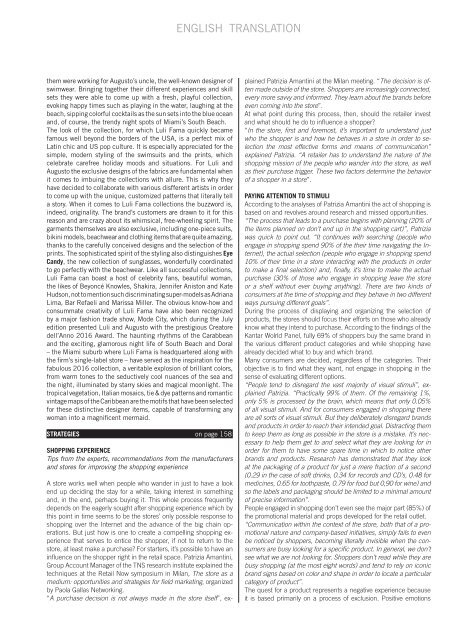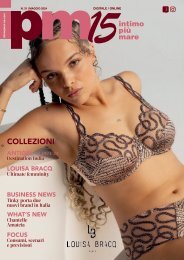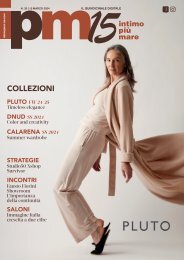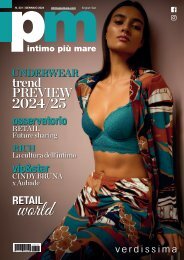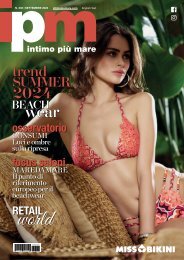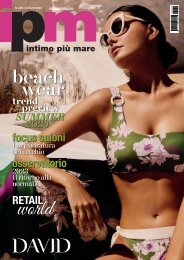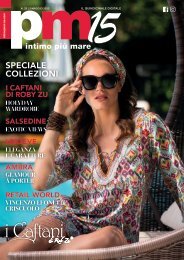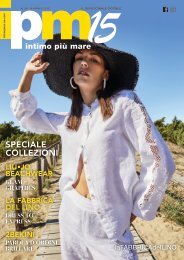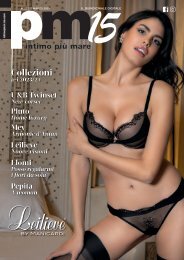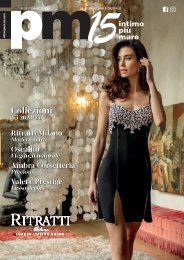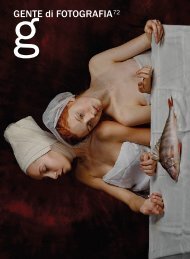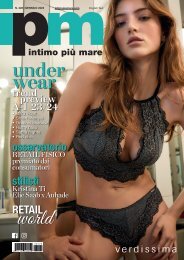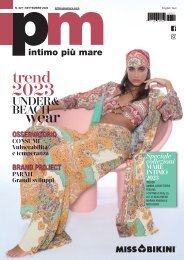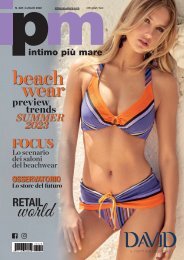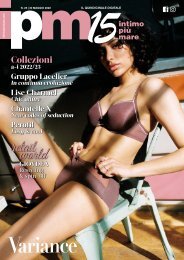You also want an ePaper? Increase the reach of your titles
YUMPU automatically turns print PDFs into web optimized ePapers that Google loves.
ENGLISH TRANSLATION<br />
them were working for Augusto’s uncle, the well-known designer of<br />
swimwear. Bringing together their different experiences and skill<br />
sets they were able to come up with a fresh, playful collection,<br />
evoking happy times such as playing in the water, laughing at the<br />
beach, sipping colorful cocktails as the sun sets into the blue ocean<br />
and, of course, the trendy night spots of Miami’s South Beach.<br />
The look of the collection, for which Luli Fama quickly became<br />
famous well beyond the borders of the USA, is a perfect mix of<br />
Latin chic and US pop culture. It is especially appreciated for the<br />
simple, modern styling of the swimsuits and the prints, which<br />
celebrate carefree holiday moods and situations. For Luli and<br />
Augusto the exclusive designs of the fabrics are fundamental when<br />
it comes to imbuing the collections with allure. This is why they<br />
have decided to collaborate with various disfferent artists in order<br />
to come up with the unique, customized patterns that literally tell<br />
a story. When it comes to Luli Fama collections the buzzword is,<br />
indeed, originality. The brand’s customers are drawn to it for this<br />
reason and are crazy about its whimsical, free-wheeling spirit. The<br />
garments themselves are also exclusive, including one-piece suits,<br />
bikini models, beachwear and clothing items that are quite amazing,<br />
thanks to the carefully conceived designs and the selection of the<br />
prints. The sophisticated spirit of the styling also distinguishes Eye<br />
Candy, the new collection of sunglasses, wonderfully coordinated<br />
to go perfectly with the beachwear. Like all successful collections,<br />
Luli Fama can boast a host of celebrity fans, beautiful woman,<br />
the likes of Beyoncé Knowles, Shakira, Jennifer Aniston and Kate<br />
Hudson, not to mention such discriminating super-models as Adriana<br />
Lima, Bar Refaeli and Marissa Miller. The obvious know-how and<br />
consummate creativity of Luli Fama have also been recognized<br />
by a major fashion trade show, Mode City, which during the July<br />
edition presented Luli and Augusto with the prestigious Creatore<br />
dell’Anno <strong>2016</strong> Award. The haunting rhythms of the Carabbean<br />
and the exciting, glamorous night life of South Beach and Doral<br />
– the Miami suburb where Luli Fama is headquartered along with<br />
the firm’s single-label store – have served as the inspiration for the<br />
fabulous <strong>2016</strong> collection, a veritable explosion of brilliant colors,<br />
from warm tones to the seductively cool nuances of the sea and<br />
the night, illuminated by starry skies and magical moonlight. The<br />
tropical vegetation, Italian mosaics, tie & dye patterns and romantic<br />
vintage maps of the Caribbean are the motifs that have been selected<br />
for these distinctive designer items, capable of transforming any<br />
woman into a magnificent mermaid.<br />
STRATEGIES on page 158<br />
SHOPPING EXPERIENCE<br />
Tips from the experts, recommendations from the manufacturers<br />
and stores for improving the shopping experience<br />
A store works well when people who wander in just to have a look<br />
end up deciding the stay for a while, taking interest in something<br />
and, in the end, perhaps buying it. This whole process frequently<br />
depends on the eagerly sought after shopping experience which by<br />
this point in time seems to be the stores’ only possible response to<br />
shopping over the Internet and the advance of the big chain operations.<br />
But just how is one to create a compelling shopping experience<br />
that serves to entice the shopper, if not to return to the<br />
store, at least make a purchase? For starters, it’s possible to have an<br />
influence on the shopper right in the retail space. Patrizia Amantini,<br />
Group Account Manager of the TNS research institute explained the<br />
techniques at the Retail Now symposium in Milan, The store as a<br />
medium: opportunities and strategies for field marketing, organized<br />
by Paola Gallas Networking.<br />
“A purchase decision is not always made in the store itself”, explained<br />
Patrizia Amantini at the Milan meeting. “The decision is often<br />
made outside of the store. Shoppers are increasingly connected,<br />
every more savvy and informed. They learn about the brands before<br />
even coming into the store”.<br />
At what point during this process, then, should the retailer invest<br />
and what should he do to influence a shopper?<br />
“In the store, first and foremost, it’s important to understand just<br />
who the shopper is and how he behaves in a store in order to selection<br />
the most effective forms and means of communication”<br />
explained Patrizia. “A retailer has to understand the nature of the<br />
shopping mission of the people who wander into the store, as well<br />
as their purchase trigger. These two factors determine the behavior<br />
of a shopper in a store”.<br />
PAYING ATTENTION TO STIMULI<br />
According to the analyses of Patrizia Amantini the act of shopping is<br />
based on and revolves around research and missed opportunities.<br />
“The process that leads to a purchase begins with planning (20% of<br />
the items planned on don’t end up in the shopping cart)”, Patrizia<br />
was quick to point out. “It continues with searching (people who<br />
engage in shopping spend 90% of the their time navigating the Internet),<br />
the actual selection (people who engage in shopping spend<br />
10% of their time in a store interacting with the products in order<br />
to make a final selection) and, finally, it’s time to make the actual<br />
purchase (30% of those who engage in shopping leave the store<br />
or a shelf without ever buying anything). There are two kinds of<br />
consumers at the time of shopping and they behave in two different<br />
ways pursuing different goals”.<br />
During the process of displaying and organizing the selection of<br />
products, the stores should focus their efforts on those who already<br />
know what they intend to purchase. According to the findings of the<br />
Kantar Wolrld Panel, fully 69% of shoppers buy the same brand in<br />
the various different product categories and while shopping have<br />
already decided what to buy and which brand.<br />
Many consumers are decided, regardless of the categories. Their<br />
objective is to find what they want, not engage in shopping in the<br />
sense of evaluating different options.<br />
“People tend to disregard the vast majority of visual stimuli”, explained<br />
Patrizia. “Practically 99% of them. Of the remaining 1%,<br />
only 5% is processed by the brain, which means that only 0.05%<br />
of all visual stimuli. And for consumers engaged in shopping there<br />
are all sorts of visual stimuli. But they deliberately disregard brands<br />
and products in order to reach their intended goal. Distracting them<br />
to keep them as long as possible in the store is a mistake. It’s necessary<br />
to help them get to and select what they are looking for in<br />
order for them to have some spare time in which to notice other<br />
brands and products. Research has demonstrated that they look<br />
at the packaging of a product for just a mere fraction of a second<br />
(0.29 in the case of soft drinks, 0.34 for records and CD’s, 0.48 for<br />
medicines, 0.65 for toothpaste, 0.79 for food but 0,90 for wine) and<br />
so the labels and packaging should be limited to a minimal amount<br />
of precise information”.<br />
People engaged in shopping don’t even see the major part (85%) of<br />
the promotional material and props developed for the retail outlet.<br />
“Communication within the context of the store, both that of a promotional<br />
nature and company-based initiatives, simply fails to even<br />
be noticed by shoppers, becoming literally invisible when the consumers<br />
are busy looking for a specific product. In general, we don’t<br />
see what we are not looking for. Shoppers don’t read while they are<br />
busy shopping (at the most eight words) and tend to rely on iconic<br />
brand signs based on color and shape in order to locate a particular<br />
category of product”.<br />
The quest for a product represents a negative experience because<br />
it is based primarily on a process of exclusion. Positive emotions


